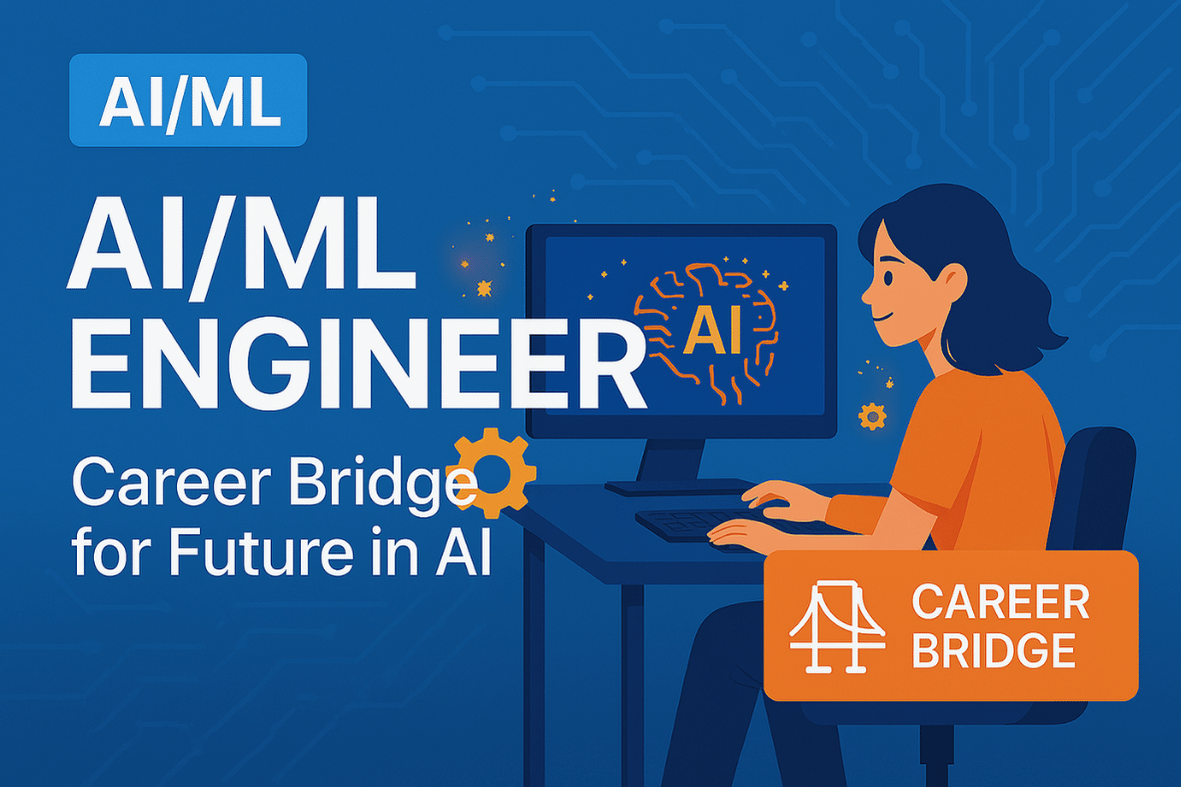ML Engineer's Career Bridge for Future in AI
The Machine Learning Engineer (MLE) stands at the forefront of technological evolution. From powering recommendation engines to deploying smart assistants and real-time fraud detection systems. But what makes a successful ML Engineer today - and more importantly, tomorrow?

A Successful ML Engineer
A successful ML Engineer is more than just a coder who knows machine learning libraries. They are system thinkers who can take a business or research problem, engineer robust pipelines, and deploy scalable, production-grade models. They combine a strong foundation in software engineering with an in-depth understanding of ML concepts, optimization, and infrastructure.
They are builders, innovators, and collaborators - bridging theory and practice, experimentation and production.
What You Will Learn
In this article, you'll gain clarity on:
- The evolving role of ML Engineers in the AI-driven world
- Core skills and tools to focus on
- Responsibilities that make you job-ready
- Preparation paths for interviews - from 1 hour to 4 weeks
- How to build a standout resume
- What to do if you’re just getting started
Why This Role Matters in the AI Future
The future of AI isn't just about research - it's about scale.
And scaling AI means:
- Handling massive volumes of real-world data
- Deploying models efficiently in production
- Monitoring and retraining them as environments evolve
- Building MLOps pipelines for automation and agility
- Enabling businesses to move fast and learn faster
This is exactly what ML Engineers make possible.
As companies shift from AI exploration to AI implementation, demand for ML Engineers is exploding across industries - from fintech and healthcare to e-commerce, robotics, and autonomous vehicles.
Key Success Factors for ML Engineers
To thrive in this role, an ML Engineer needs:
- Strong coding practices with clean, modular, production-grade code
- Deep understanding of ML models and how they behave in the wild (overfitting, data drift, performance degradation)
- Ability to deploy and scale ML solutions in real-world environments
- Collaboration with cross-functional teams: data scientists, product managers, DevOps, and stakeholders
- Proficiency with data infrastructure: data pipelines, feature stores, and model monitoring
Key Responsibilities of an ML Engineer
- Design and build data ingestion pipelines and feature engineering workflows
- Train, validate, and optimize machine learning models
- Deploy models to production environments using CI/CD practices
- Monitor model performance and trigger retraining when necessary
- Work with data scientists to transition research into production-ready code
- Build and maintain MLOps systems (versioning, deployment, rollback, etc.)
- Ensure compliance with data privacy and ethical AI practices
Capabilities for the Job
- Programming: Python (must-have), Java/Scala/C++ (nice-to-have)
- ML Frameworks: TensorFlow, PyTorch, Scikit-learn
- Data Skills: SQL, Pandas, Spark
- Deployment Tools: Docker, Kubernetes, MLflow, Airflow
- Cloud Platforms: AWS (SageMaker), GCP (Vertex AI), Azure (ML Studio)
- Monitoring & Logging: Prometheus, Grafana, Sentry
- Version Control & CI/CD: Git, Jenkins, GitHub Actions
Top Tools to Learn and Crack the Interview
- Data Engineering: Apache Airflow, Kafka, Spark
- Model Deployment: Docker, Kubernetes, FastAPI, Flask
- Experiment Tracking: MLflow, Weights & Biases
- Pipeline Orchestration: Kubeflow, TFX
- Monitoring: Evidently AI, Arize AI
- Model Optimization: ONNX, TensorRT
- Coding Platforms for Prep: LeetCode, HackerRank (ML-specific challenges), StrataScratch (SQL)
Top Keywords to Include in Your CV
- ML Pipeline Development
- Model Deployment and Monitoring
- MLOps and CI/CD for ML
- Data Preprocessing and Feature Engineering
- Real-time Model Inference
- Model Optimization and Tuning
- Cloud-based ML Solutions (AWS/GCP/Azure)
- Deep Learning Frameworks (PyTorch, TensorFlow)
- API Integration for ML Services
- Scalable AI Systems Design
Make sure your resume reflects outcomes: “Deployed fraud detection model reducing false positives by 22% in real-time system” > “Worked on fraud detection.”
Don’t Have the Experience? Do Internship With Us.
🚀 Ready to jumpstart your ML Engineering career but don’t have hands-on experience?
Join our ML Engineering Internship and work on real-world projects with mentorship, exposure to MLOps tools, and resume-boosting deliverables.
➡ Apply now. Your AI journey starts here.
If You Had Only 1 Hour to Prepare for an ML Engineer Interview
🔍 Focus on the following:
- Review one real-world ML pipeline (e.g., recommendation system, fraud detection, etc.)
- Brush up on model evaluation metrics (ROC-AUC, Precision/Recall, F1 Score)
- Understand basic MLOps principles: CI/CD for ML, model versioning, and retraining
- Be ready to discuss one ML project: business problem, data processing, model choice, deployment
- Practice 2 coding questions (e.g., from LeetCode’s ML tag)
Prepare for It: 1 Day, 1 Week, 4 Weeks
1 Day Plan
- Revise ML algorithms and when to use them
- Review deployment stack: Flask + Docker + AWS
- Go through 1-2 ML system design questions
- Practice explaining your project end-to-end
1 Week Plan
- Code 2-3 ML pipelines from scratch (EDA → Train → Deploy)
- Set up model tracking and basic MLOps using MLflow
- Revisit Python, SQL, and data manipulation skills
- Mock interview: system design + behavioral + case study
4 Week Mastery
- Build and deploy a portfolio ML project on GitHub (with CI/CD)
- Take an MLOps course (e.g., by Andrew Ng or Databricks)
- Learn cloud deployment (AWS Sagemaker or Vertex AI)
- Deep dive into 2-3 case studies from top tech companies
- Conduct mock interviews with peers or mentors weekly
The road to becoming a Machine Learning Engineer is one of learning, building, and optimizing - not just models, but yourself.
Whether you have one hour or one month, use it wisely.
The AI world is waiting. 🔥

